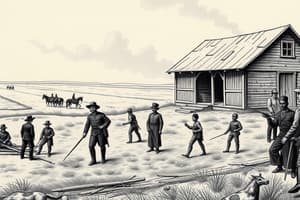Podcast
Questions and Answers
What was the primary goal of the Kansas-Nebraska Act of 1854?
What was the primary goal of the Kansas-Nebraska Act of 1854?
- To promote peace between pro-slavery and anti-slavery factions
- To organize the territories and determine the legality of slavery through popular sovereignty (correct)
- To abolish slavery in the territories of Kansas and Nebraska
- To implement the Missouri Compromise in the new territories
Which event is referred to as 'Bleeding Kansas'?
Which event is referred to as 'Bleeding Kansas'?
- The violent conflicts arising from the Kansas-Nebraska Act (correct)
- The peaceful negotiation between pro and anti-slavery settlers
- The passage of the Missouri Compromise
- The establishment of the Republican Party
How did Abraham Lincoln's election in 1860 influence Southern states?
How did Abraham Lincoln's election in 1860 influence Southern states?
- It encouraged Southern states to unite with the North
- It was a major factor leading to the secession of several Southern states (correct)
- It was largely accepted by all Southern factions
- It led to increased support for the Union in Southern states
What stance did Stephen A. Douglas take regarding the issue of slavery?
What stance did Stephen A. Douglas take regarding the issue of slavery?
What was one of the key viewpoints of secessionists following Lincoln's election?
What was one of the key viewpoints of secessionists following Lincoln's election?
What was the primary aim of the Missouri Compromise?
What was the primary aim of the Missouri Compromise?
Which provision was a result of the Compromise of 1850?
Which provision was a result of the Compromise of 1850?
What was the outcome of the Dred Scott Case?
What was the outcome of the Dred Scott Case?
What geographical line was established by the Missouri Compromise to limit slavery?
What geographical line was established by the Missouri Compromise to limit slavery?
Which act was strengthened as part of the Compromise of 1850?
Which act was strengthened as part of the Compromise of 1850?
What principle allowed the residents of New Mexico and Utah to decide on slavery?
What principle allowed the residents of New Mexico and Utah to decide on slavery?
What was a significant consequence of the Dred Scott decision?
What was a significant consequence of the Dred Scott decision?
What was the main goal of the Compromise of 1850?
What was the main goal of the Compromise of 1850?
Flashcards
Kansas-Nebraska Act (1854)
Kansas-Nebraska Act (1854)
Allowed residents of Kansas and Nebraska to decide whether or not to allow slavery through popular vote.
Bleeding Kansas
Bleeding Kansas
The violent clashes between pro-slavery and anti-slavery settlers in Kansas. These conflicts escalated tensions and bloodshed, earning the territory the name 'Bleeding Kansas'.
Election of 1860
Election of 1860
A pivotal election where Abraham Lincoln, opposed to slavery expansion, won the presidency. This victory triggered the secession of Southern states, leading to the Civil War.
Abraham Lincoln
Abraham Lincoln
Signup and view all the flashcards
Secession
Secession
Signup and view all the flashcards
Missouri Compromise (1820)
Missouri Compromise (1820)
Signup and view all the flashcards
Compromise of 1850
Compromise of 1850
Signup and view all the flashcards
Dred Scott Case (1857)
Dred Scott Case (1857)
Signup and view all the flashcards
Fugitive Slave Act
Fugitive Slave Act
Signup and view all the flashcards
Popular Sovereignty
Popular Sovereignty
Signup and view all the flashcards
36°30' Parallel
36°30' Parallel
Signup and view all the flashcards
Missouri's Admission
Missouri's Admission
Signup and view all the flashcards
Maine's Admission
Maine's Admission
Signup and view all the flashcards
Study Notes
Missouri Compromise (1820)
- Aimed to balance power between free and slave states in the U.S. Senate.
- Missouri admitted as a slave state.
- Maine admitted as a free state.
- 36°30' parallel established, limiting slavery north of the line, except in Missouri.
- Missouri was the first slave state admitted under this compromise.
Compromise of 1850
- Resolved tensions after the Mexican-American War over new territories' status.
- Included California's admission as a free state.
- Strengthened the Fugitive Slave Act, requiring citizens to assist in capturing runaway enslaved people.
- Allowed Utah and New Mexico territories to decide on slavery through popular sovereignty.
- This Compromise aimed to settle the slavery question in new territories.
Dred Scott Case (1857)
- Dred Scott, an enslaved person, sued for freedom.
- The Supreme Court ruled against Scott, determining enslaved people were property, not citizens.
- This decision declared the Missouri Compromise unconstitutional.
- This ruling made slavery legal in all territories.
Kansas-Nebraska Act (1854)
- Organized Kansas and Nebraska territories.
- Allowed popular sovereignty (voters deciding on slavery) in these territories.
- Repealed the Missouri Compromise's restriction on slavery.
- Led to violent conflicts between pro- and anti-slavery settlers in Kansas ("Bleeding Kansas").
Election of 1860
- Lincoln (Republican) opposed expanding slavery.
- This opposition led to Southern states' secession from the Union.
- Lincoln's victory was a major factor in the start of the Civil War.
Viewpoints on Lincoln's Victory
- Unionists wanted to stay in the Union.
- Secessionists wanted to leave the Union.
- Cooperationists wanted to leave the Union only if other Southern states supported it.
Studying That Suits You
Use AI to generate personalized quizzes and flashcards to suit your learning preferences.




